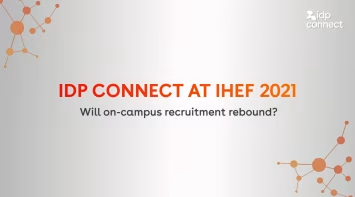Which markets catch your eye today? When deciding where to spend your recruitment and marketing dollars, there are many variables to evaluate. From your institution’s history in certain countries (alumni, current students, institutional partnerships, etc.), macro-trends in international student mobility, the development of appropriate messaging campaigns, type of desired presence (in-person, 3rd party, or virtual), to an analysis of available data, you have much to consider.
Recent history
Vietnam did not enter the top 20 sending countries to the United States until 2006-7 when 6,036 students from this emerging southeast Asian nation enrolled in U.S. colleges, universities, and intensive English programs according to Open Doors 2007. After several double digit increases, by 2018, Vietnam had risen to the 6th leading place of origin with over 24,000 students at U.S. post-secondary institutions. Keep in mind, another growing cohort of Vietnamese have started attending high schools in the United States as well.
In the early parts of this wave, ESL programs and community colleges benefited from the sudden rush of students. Now, while the largest percentage of Vietnamese students in the U.S. are studying for bachelor’s degrees, almost a quarter still attend community colleges, while almost 1500 now are in ESL programs here (data based on the most recent SEVIS by the Numbers report from March 2019). While many countries will see decreases in the 2019 Open Doors Report come November, Vietnam will likely not be one of them with 3% growth overall in the last six months, led by bachelor’s degree and high school students, as seen in this snapshot from the SEVIS data comparing March 2019 to August 2018 real-time information.

Vietnam: All Study Destinations Student Breakdown
While many Vietnamese now study in the U.S., we are not the #1 destination for these students (the U.S. is in second place). Believe it or not, Japan has more than 72,000 Vietnamese studying at its colleges and universities. After the U.S., South Korea, Australia, and Canada round out the top 5 countries where students from Vietnam go for study. Canada, in particular has become the hot destination in the last four years, growing from 5,000 to 20,000 in that short time.
As we have talked about in previous articles, it is absolutely essential in this current global student mobility environment to be aware not only of your fellow U.S. colleges competing for the same students, but also what other destination countries are active in recruiting in each target markets. Canada certainly needs to be on the radar for U.S. institutions when discussing Vietnam. In an ironic twist, Vietnam has now overtaken the United States to become the 5th leading country of origin for international students studying north of our border, up 46% in one year.
Looking at IDP Connect’s Insights tool, doing a year-on-year snapshot comparison of over 1.1 million Vietnamese students using the Hotcourses platform, the U.S. does hold a narrow lead. Australia, UK, and Canada are close behind. Canada’s growing appeal on Hotcourses matches larger macro trends occurring. In fact, the top three destinations, according to this Insights data, have all lost market share to Canada in the last year.

When looking for a typical profile of the average Vietnamese student on Hotcourses, nearly two-thirds are female, with slightly under half of which are seeking undergraduate degrees. Interestingly, just over one-third are accessing Hotcourses sites via mobile devices. This data point is very interesting for anyone who’s traveled to Hanoi or Ho Chi Minh City and marveled at the immense number of motorcycle and scooter drivers who are on their mobile phones as they navigate traffic. Perhaps we should feel some comfort knowing that the greater majority are taking the time to do their research on Hotcourses while seated at a desktop or laptop.
Vietnam: United States Student Breakdown
Data can be very revealing when used to analyze how to approach any market. In Vietnam, a year-on-year look at the typical student using Hotcourses that is considering the U.S. as their top destination choice is increasingly female (over 71%), nearly 60% interested in undergraduate studies, with less than one-third using mobile devices to access the platform.

What do they want to study?
The good news for institutions that are not heavy on STEM programs, is that Vietnamese students have a broad range of academic interests that attract their attention. Business/management, health/medicine, creative arts/design, social studies/media, and then engineering are the top five areas of interest for U.S.-bound Vietnamese.

Where they live?
Not surprisingly, two thirds of US-interested Vietnamese students using Hotcourses are in Ho Chi Minh City and Hanoi. The next largest city/province of origin is Da Nang with less than 5%. From where are they accessing content online?
The top locations online where Vietnamese students are accessing U.S. higher education-related content: • Secondary schools • Test-prep and tutoring companies • Foreign language study businesses • Business and productivity software • Post-secondary institutions
Conclusions
From the available data points, U.S. institutions’ general messaging to Vietnamese students using Hotcourses should take in consideration these items: 1. Largely female, undergraduate audiences 2. Greater majority of interested students in two largest cities (Hanoi, Ho Chi Minh City) 3. Academic interests represent a broad spectrum of majors, not solely STEM 4. Students access content most from educational locations – schools, colleges, test-prep, tutors 5. Comparative value propositions of competitor nations, especially Canada, UK, & Australia.
Next up in June, off to Brazil for a deep dive on how this market shapes up for U.S. institutions.
You might like...

Changing Parental Perceptions and Motivations in the International Education Decision Making Process
Parents are now more concerned about graduate employment opportunities than distance from friends and family.

Growing Student Markets in Africa to Watch in the Next Decade
Source market population and economic growth are key factors

How High Cost of Living and Global Economic Instabilities are Affecting International Student Perceptions
Supporting and encouraging prospective students to do financial research and their sums.



